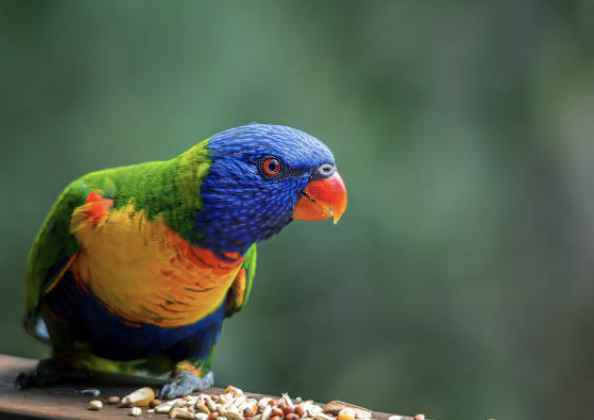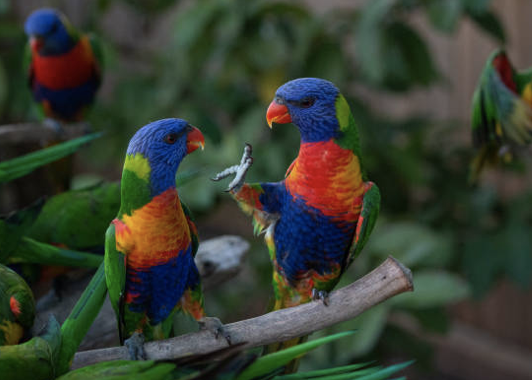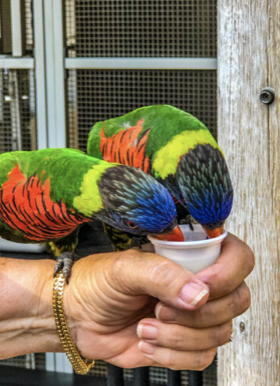Summer Exhibit: Lorikeets

Species Identification and Distribution:
Lorikeets and lories are a subfamily of parrots, called loriinae. Within this subfamily there are over 50 different species. The main difference between Loriinae and parrots is the distinct “brush-like” tongue (see more in adaptations). It is difficult to tell lorikeets and lories apart aside from a couple visual clues. Lories tend to be larger with a shorter squared off tail while lorikeets tend to be smaller, with longer, pointed tails. In addition, lories tend to be red with patches of yellow, purple, and green; while most lorikeets are green with patches of red and yellow. Please note that these are generalizations due to genetic diversity in colorings and lengths from individual to individual.
Lorikeets and Lories are spread throughout the South Pacific, Papua New Guinea, and Australia. Many birds in this family are “commuters” and will travel from island to island in search of food, often flying together in flocks. They are strictly arboreal therefore will be found only in areas with tree coverage such as forests, mangroves, and eucalyptus groves.
Adaptations/unique features:
The most striking feature of the lories and lorikeets is of course its bright colorings. Something not unusual to the larger parrot family, loriinae uses their coloring for, what new research tells us is for 2 reasons. There are many species that use it for camouflage from predators as much of the patchwork is green, while the other brightly colored patches serve to stand out to their own species for mating purposes as well as simply identifying each other. The variety in this serves well when interacting with guests- they are likely to say the right answer which makes them feel great!
Lorikeet color "multi-tasking" study: https://www.amnh.org/explore/news-blogs/evolution-lorikeet-color
Lorikeets have a beneficial foot shape known as being zygodactyl. This means that they have 2 toes pointing forward and 2 pointing backward in an X shape. This adaptation allows them to be strictly arboreal, giving them great grip on tree branches. Woodpeckers, owls, and ospreys are a few other commonly known birds that share this trait.
Zygodactl feet https://www.aiwc.ca/blog/bird-feet-particular-adaptations-with-prehistoric-roots/
One of their most important adaptations is their beak shape and tongue. They have a long upper bill that points downward that allows them to reach seeds in unique shaped plants. Their tongue is covered in tiny hair-like structures called "papillae." When they stick out their tongues to eat, these papillae act like brushes soaking in the nectar and pollen from flowers. These brush-like tongues also help scrape juices from fruits they eat.
Lorikeets and Lories are about 6-15 inches in length depending on the species and about 7-10 ounces.
Life span & Reproduction:
In their natural habitat Lorikeets can live about 7-10 years in favorable conditions. Within human care, this can be doubled to about 20 years with good care.
Males and females within TMA exhibit look alike, but overall some species are sexually dimorphic meaning males and females look different. DNA testing is the most accurate, and in many cases, the only way to tell their sex.
The breeding season is often between August and January, but their breeding is quite varied from species to species as well as contributing factors such as climate and resources. These birds are monogamous and often breed throughout the year as well.
Couples make their nests in the hollows of trees very high above the ground, and often layer with coverings of decayed wood and sticks. Females lay 2 eggs and will sit on them while the male assists with feeding the female as well as the chicks once they are hatched. The chicks are born similarly to other parrots and birds without eyes and feathers- they slowly grow plumage and are able to fly after 7-8 weeks.
Diet:
A unique aspect of lorikeets and lories is their diet of flowers, pollen, and nectar! They will also eat fruits and seeds, but this isn’t the main part of their diet. This differs from other parrot species that have a diet mainly of nuts and seeds. The lorikeets, gizzards and crops are therefore weaker.
In the TMA exhibit guests have the option to feed nectar to the lorikeets, with supplemental bowls of nectar given during low guest counts. There are also supplemental fruits and veg given once per day (either in morning or afternoon depending on animal behavior and weather). 
Ecological Importance:
Lories and Lorikeets play an important role as both dispersers and potential pollinators in their native habitats. Their diet of fruit allows them to disperse seeds through manipulation of the fruit with their beaks as well as consumption/excretion. They work as potential pollinators with their interactions between flowers, pollen, and nectar. These birds contribute to the pollination of many fruits and flowers, working alongside other main pollinators such as the flying fox and other bird species (honeyeaters).
Rainbow Lorikeets as important pollinator of Cocos, Cornell Birds of the World: https://birdsoftheworld.org/bow/species/railor5/cur/introduction#food
Rainbow lorikeets as pollinators Harvard study: https://ui.adsabs.harvard.edu/abs/2024OrniR..33....3S/abstract
Threats and Conservation:
The parrot family is listed by CITES in Appendix II. This explains that species that are not necessarily threatened with extinction now, but that may become so unless trade is closely controlled. It also includes so-called "look-alike species", i.e. species of which the specimens in trade look like those of species listed for conservation reasons.
Lories and Lorikeets are beautifully colored and of a smaller size than some common parrots. This makes them an attractive member of the pet trade and are often captured from the wild for that reason.
These birds have a taste for commonly farmed crops such as figs, coconuts, and grapes which can hurt the farmers' crops and livelihood. This makes farmers likely to use forms of pest control on them. Many farmers have chosen to plant other more favorable nectar rich flowers and non-crop fruits in other parts of their farm to keep lorikeets from feeding on their crop.
Since lories and lorikeets are arboreal, rapid deforestation is a main concern for them, which is mostly due to logging in their habitats.
Maritime Aquarium Lorikeets:
The aviary is an open greenhouse structure 26’x 72’ (1872 square feet) where birds fly freely over your heads and land on you. The structure is escape proof with covered with zoo mesh and double-door entry and exit halls. The shade cloth limits the UV but allows rain. 4 stations or areas of coverage are staffed to assist the public and animals in the exhibit.
There are 9 species found in the aviary at TMA, with 55 birds in total. Species include:
- Red lorikeet- Eos bornea
- Olive headed lorikeet - Trichoglossus euteles
- Musky lorikeets - Glossopsitta concinna
- Black capped lorikeets – Lorius lory
- Green lorikeet Trichoglossus chlorolepidotus
- Leaf lorikeet - Trichoglossus weberi
- Red naped lorikeet - Trichoglossus rubritorquis
- Swainsons lorikeet - Trichoglossus moluccanus
- Stella lorikeet- Charmosyna papou
Animal Observation and Behaviors:
The interpretive goal of the exhibit is to encourage guests to participate in animal observation, by taking time to view not only the beauty of the lorikeets but their unique behaviors too. Taking time to observe animals both at AZA facilities and in their natural habitats is a great way to connect and build empathy for those organisms.
In AZA facilities the use of animal observations is crucial for their overall care. A documented observation of an animal is called an Ethogram. Ethograms help us to understand and interpret an animal's behaviors against variables such as time of day, food, exhibit design, guest counts, and many more! Ethograms can be done over long periods of time, or short periods of time. They can be done by hand, noting behaviors with timestamps, or done through various software applications that set variables and time for you.
The great benefit about ethograms is the ability for people of all ages to perform them! Ethograms for someone in early childhood can look like checking off if they see an animal do a behavior they are familiar with (i.e. drinking water, laying down, making noise, running, etc). It can also look more advanced for a high schooler or college student completing a semester-long project on how different enrichment items change behaviors of a certain animal. It can look like an avid birder noting the behaviors of their favorite bird seen on a daily walk and how it changes over the seasons. The variety allows everyone to not only become connected with animals in a deeper way, but allows everyone to participate in science!
In this Lorikeet Exhibit encourages guests to spend time watching one or a few birds. What movements are they doing? What noises can you hear? What areas of the exhibit do they prefer? How do they interact with others both guests and birds? Questions can be simple for younger guests; “are any birds in here eating? What colors can you see on the birds? How do they use their wings, feet, or beak?
Guest Guidelines:
- All visitors must sanitize hands before entrance
- No strollers
- No food or drinks
- One-way traffic in exhibit
- Visitors can not “pet” the birds
- Visitors should not bring birds close to their faces for “kisses”
- This is for the health and safety of the guest and animal, please politely explain this to them.
Exhibit Expectations Via Animal Husbandry:
- VISITORS WILL BE SURPRISED WHEN A BIRD FIRST LANDS ON THEM. Birds will land on visitor’s heads, shoulders and arms. This can hurt if not covered. MOST VISITORS WILL LIKE IT –some might be scared – be patient and pay attention to their needs.
- BIRDS ARE MOST ATTRACTED TO THE NECTAR – may not approach a visitor who doesn’t have any.
- BIRDS ARE ALSO ATTRACTED TO SHINY THINGS: HAIR, GLASSES, EARRINGS, NECKLACES, HAT VELCRO and will climb and chew on them. They’re curious animals!
- POOP WILL HAPPEN: Get used to it. You can wear a hat. Paper towels will be available outside the exhibit if needed.
- If they look uncomfortable: Approach them and ask if they are ok. Ask if they want you to remove the bird. Be patient – they might just need to get used to it. Look for signs of distress but always ask first.
- SEVERAL OPTIONS TO MOVE BIRD (gently)
1.Best first step is to move the nectar to lure them away
2.Have stick for back up
3. Put nectar on railing
- FOR TIMID VISITORS: Try suggesting that they enter without nectar or they can watch from outside. Please encourage them to try it!
Be mindful of normal and abnormal bird behavior:
- Squabbling birds: Sometimes this is just play, if there’s aggressive behavior you can let husbandry know.
- Excessive biting to visitors: The husbandry staff will be the one who will place any bird in a time out and release any bird placed in a time-out, if needed due to poor behavior.
- Sick vs. Resting: A sleeping or resting bird may have head tucked, with foot out – leave him alone. A sick bird might display symptoms that could include eyes half closed, puffed up, panting, and nasal discharge, lethargic & isolated.
- Behavior Notes: Learn your birds! If possible let us know what species, give us some photos. Each species can have slight variations as to what is normal.